Deepblu Introduces the COSMIQ Dive Computer
UPDATE 9/30/24: This article should be helpful to someone thinking of buying a use Cosmiq dive computer, but there have been several updates to models since I wrote this. Keep that in mind as you read on. If I can make time, I’ll review the newest Cosmiq if I can get my hands on one to take underwater.
UPDATE 10/24/16: The v.9 COSMIQ firmware update includes a setting for freshwater. There are a few other updates since I wrote this article. I’ll do my best to keep it up to date.
Like most divers, I am an absolute dive gear junkie. I love dive gear. I love learning about dive gear, testing dive gear, buying new dive gear, and everything else about dive gear. At the same time, I tend to be a purist. I obsess over diving equipment because diving equipment provides life support, which is serious.
I recently wrote an article for SUBMERGE Magazize that addressed the decision to buy dive gear vs. renting. In that, I suggested that many divers choose to buy more personal items, like masks and regulators first. I believe dive computers fit into this category. However, dive computers tend to be expensive, so that’s a purchase divers often put off for a while. COSMIQ changes that by providing a feature-packed dive computer for a surprisingly low price.
Entry Level Dive Computers
Many dive computers are available that are promoted as entry-level or for backup. Examples include the Mares Puck, Genesis Resource Pro, Suunto Zoop and Oceanic B.U.D., among others. In my opinion, these are all good, but there are three things that I look for that low-cost dive computers tend not to include.
- Bright, easy to read, full color LED or similar display
- Wireless connectivity (typically, Bluetooth)
- Standardized, exportable dive data
COSMIQ provides the first two, and I have high hopes for number 3 sometime in the future. The display alone makes COSMIQ a joy to dive.
Unpacking the COSMIQ Dive Computer
COSMIQ is packaged in a rigid clamshell case, which makes big points with me. If you’ve read any of my other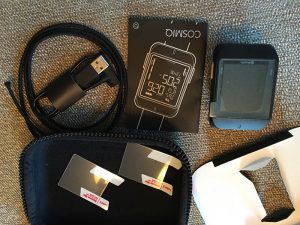 articles, you know I have been diving with a pair of
articles, you know I have been diving with a pair of
Shearwater Petrel technical dive computers for a long time. At 3 times the price, you would think the Petrel would include a similar case. But, no. That’s an accessory you have to buy for additional $30. Consequently, mine travel around in a couple Crown Royal pouches.
Packaged with the computer is a USB charging cable, quick start guide, 2 protective covers (adhesive) for the display, and a couple feet of bungee cord to substitute the standard strap.
If you’re diving with a drysuit, bungees can be a huge help–especially with dry gloves. Here’s a step-by-step pictorial from Deepblu showing how to convert from the standard COSMIQ strap to the bungee:
COSMIQ Bungee Mount: Step 1
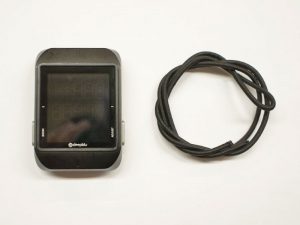
COSMIQ Bungee Mount: Step 2
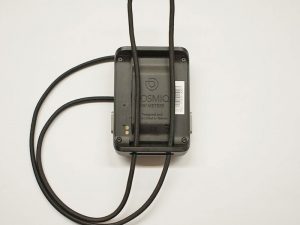
COSMIQ Bungee Mount: Step 3
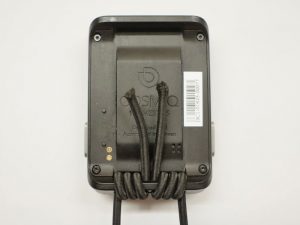
COSMIQ Bungee Mount: Step 4
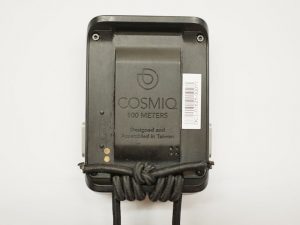
COSMIQ Bungee Mount: Step 5
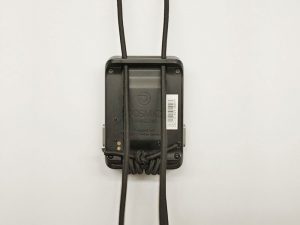
COSMIQ Bungee Mount: Step 6
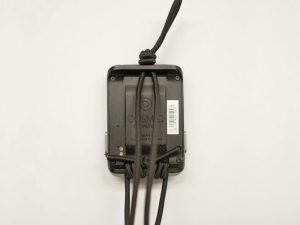
COSMIQ Dive Computer Features
The first thing I did when COSMIQ arrived, was to download the manual from the Deepblu website, so I could read it on my iPad or iPhone. My heart sank when I read the following:
WARNING: DO NOT USE COSMIQ AS YOUR PRIMARY DEVICE IF YOU PLAN TO DIVE AT AN ALTITUDE ABOVE 300M. COSMIQ cannot accurately calculate decompression schedules for dives at altitudes greater than 300 meters/985 feet. Failure to heed this instruction will result in inaccurate measurements and therefore may cause you to dive beyond safe limits, increasing your risk of serious injury or death.
“Well crap,” I thought, “fat lot of good that’s going to do in Tahoe.” But, I LOVE that bright, full color display, so my thinking was that I’d take it underwater with my other dive computers just to see how they compare. Then, I thought about gauge mode… My hope was that altitude settings would be coming in a future firmware update.
Firmware Updates with COSMIQ & v0.8 Altitude Setting
COSMIQ, the computer and mobile app, are both in active development, so I wasn’t surprised to be prompted for an update the first time I connected it to my phone. The update process is simple. In this case, I was updating to v0.7. The the only issue was that the app kept prompting me for the same update even after I had it installed.
A few days ago, however, firmware v0.8 came out. I didn’t bother with the manual right away, but I did notice a new setting: Altitude. YES! Sure enough, there’s an altitude setting for elevations above 985 feet. Naturally, I needed to know more, so I downloaded the new manual. Here’s what it says…
Altitude: Set the altitude settings for your dive. Depending on where you are, you can set COSMIQ to Sea Level or Above 300 meters / 985 feet. The default is Sea Level.
Oddly, the warning about NOT diving at altitude with COSMIQ is still there, but I suspect it is because it was updated very recently and simply got by the editor. Now, the only issue is that there’s no adjustment for fresh water. That means the depth readings will probably be off by a foot every 33 feet.
What impact that has on no-decompression calculations remains to be seen. Tomorrow, I’ll get it in the water alongside my Shearwater Petrels for comparison.
Deepblu chose the Buhlmann ZH-L16 decompression algorithm. I’m not going to go into a dissertation about gradient factor vs. bubble models, but my personal feeling is that Deepblu made a good choice.
The important thing to note is Deepblu’s recommendation:
Water Type: COSMIQ does not offer the ability to change the algorithm based on the type of water you are diving in. The algorithm is programmed to perform calculations based on the effects of diving in salt water. If you are planning to dive in fresh water, please note that the depth readings and decompression calculations will not be completely accurate. Therefore, we recommend that you do not use COSMIQ as your primary device if you are diving in freshwater.
My guess is that a setting for freshwater is likely forthcoming. Meanwhile, I’ll be diving with two additional dive computers when I test the new altitude setting for the COSMIQ. In other words, I’m sticking with Deepblu’s recommendation not to rely on it is my primary device.
The Deepblu Mobile App
The COSMIQ was engineered to work closely alongside the Deepblu App. In fact, the app is a requirement for firmware updates, and many (if not most) of the computer’s settings. As mentioned, the first thing I did was to sync the COSMIQ dive computer with my iPhone.
Connecting through Bluetooth was immediate. I didn’t have to fiddle with it to get it to pair, and the two connect easily whenever I want them to.
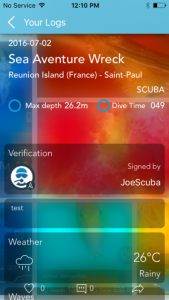 One feature I like a lot is that I can “sign” student log books through the app. To do that, Deepblu verified my instructor credentials, thus providing “signing” capability when I log in. In theory, my students would then be able to present the verified log as proof that a particular dive had been completed.
One feature I like a lot is that I can “sign” student log books through the app. To do that, Deepblu verified my instructor credentials, thus providing “signing” capability when I log in. In theory, my students would then be able to present the verified log as proof that a particular dive had been completed.
I say, “in theory” because even though the function works perfectly, PADI and other agencies have their own standards for verification, and I’m not sure they’ll consider it proof. As an example, if a student were to come to me as a referral, I’d need evidence of previous dives presented to me in PADI’s format, using PADI’s official log. In other words, there are limitations on what instructors are allowed to use as proof of experience.
For now, it is a feature that has a lot of promise, and I’ll watch to see where it leads. Official or not, verifying dives remotely is handy, and I like the community aspect of that as well.
Using the Deepblu App
My feeling is that Deepblu is in a relatively early development stage with both the app and the computer. This is at least partially verified by the fact that the current firmware version is v0.8. If they’re following standard engineering practices, a stable, fully tested release would be numbered v1.0 or higher.
New features have been included in every release, which is great. So far, the software works perfectly and I have not encountered any bugs or incomplete functions.
I suspect a similar condition for the app. I found the app easy to use for about 90% of its functions. Changing COSMIQ settings from the app is required for the major functional settings. These are things like altitude and conservatism that you tend not to change very often.
Settings you’d need to adjust before a dive or on a boat can be changed directly on the dive computer. An example of that would changing from air to Nitrox, or from one Nitrox mix to another.
At the end of the dive day, it only takes a few seconds to upload your dives to log them in the Deepblu app. There are no cables to fuss with or any special procedures. You simply connect and push a few buttons. Once there, you can navigate to the exact dive site on a live map and save the dive.
Social Interaction Using the Deepblu App
One obvious goal for Deepblu is to get as many divers as possible to use the COSMIQ dive computer, along with the app, for all of their diving activities. As their network of divers grows, the app will provide a cool way for divers to find each other and interact socially.
Using the dive log, any point during the dive can be tagged with a photo or video. Viewing them simply requires scrolling to that point in the dive with your finger. It is very cool.
Summing Up… For now…
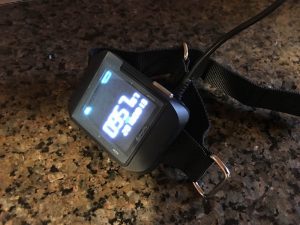 So far, I love the Deepblu COSMIQ. The screen is beautiful and the computer is intuitive to operate. I would like to the see the dive time displayed more prominently, but that’s just a personal thing. Uploading dive data, running updates and changing settings using Bluetooth is a huge plus. No additional cables to buy, and no worries about failed connectors. Also, the COSMIQ dive computer is rechargeable, providing 6-7 hours of dive time per change. All of this is typical of a much expensive computer.
So far, I love the Deepblu COSMIQ. The screen is beautiful and the computer is intuitive to operate. I would like to the see the dive time displayed more prominently, but that’s just a personal thing. Uploading dive data, running updates and changing settings using Bluetooth is a huge plus. No additional cables to buy, and no worries about failed connectors. Also, the COSMIQ dive computer is rechargeable, providing 6-7 hours of dive time per change. All of this is typical of a much expensive computer.
The one thing that bugs me is there is no way that I’ve discovered to sync COSMIC dive data with any other logging platforms. So, if you want to use an online dive log like divelogs.de, or sync with a program like Subsurface, currently that doesn’t seem possible. I understand wishing to keep data proprietary, but there’s a lot to be said for standardization.
In Part II, I will get into the details of diving with COSMIQ. As a hint, I like it a lot–especially that bright, colorful display. Look for that over the next few days. In the mean time, I welcome your comments.


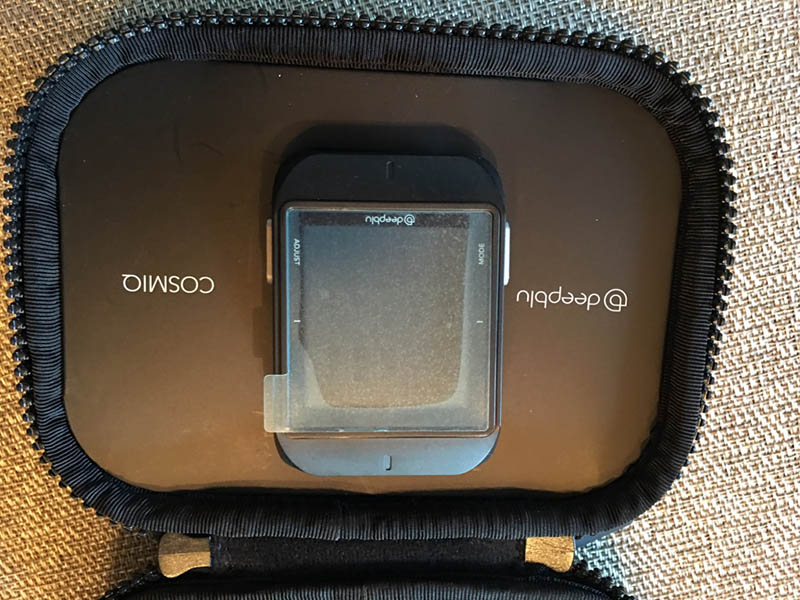
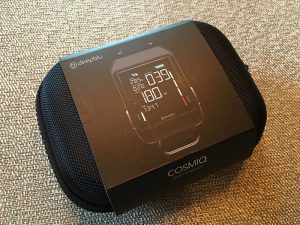
Hey Joe, I’m currently using a Sunnto DX but heading to a new job next month in a more remote location. I’m looking to find a computer that doesn’t fail as often as the Sunnto range and obviously the COSMIQ is one that I am considering. Have you done many dives on it yet? and if so, what’s your thoughts?
Hi Matt,
I have about 25 dives with COSMIQ. So far, there hasn’t been a single issue. Last night there was another firmware update (v0.9) that added a freshwater setting. So, if you will have access to the Internet, you can expect additional features and updates fairly regularly.
In my experience so far, Deepblu is very responsive to customers. My feeling is that the COSMIQ dive computer is perfect, but I still only have 25 dives with one, so it may be a little early to tell. One thing, I have not seen or spoken with anyone who has had problems.
– Joe
Cheers Joe, I reckon I’ll give it a go, should be hitting 3-5 dives daily once I’m in Papua so I may be able to hand you back some of my thoughts on it. Thanks again
That’s great! Send some pictures! What a cool place to go. – Joe
Hi Matt & Joe,
I also considering this as my first dive comp. and i looked in indonesian diver there still a few or might only you Matt that using this divecomp. How’s your review as i recon that you already more than 25 dives using this.
I wonder as i think that water temperature (which in our place/indonesia) will totally different with Joe testing.
Looking forward for your input Matt. Thanks
Any idea how sturdy this computer is? I am considering buying one, but I dont have a great trackrecord with keeping computers in one piece.
I’ve been using the COSMIQ dive computer for a couple months now and it still looks like it did the day I got it. The case is rated to 330 feet, and there are no removable connectors or battery ports. In my experience that’s where failures occur most of the time. If you are abusive to dive computers, I hope you’ll try to be a little more careful. All dive computers are electronic devices that you depend on to keep you safe. Let me know what you decide! – Joe